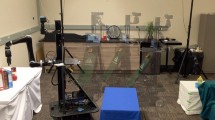Abstract
This paper describes a new approach to robot motion planning that combines the end-point motion planning with joint trajectory planning for collision avoidance of the links. Local and global methods are proposed for end-point motion planning. The joint trajectory planning is achieved through a pseudoinverse kinematic formulation of the problem. This approach enables collision avoidance of the links by a fast null-space vector computation. The power of the proposed planner derives from: its speed; the good properties of the potential function for end-point motion planning; and from the simultaneous avoidance of the links collision, kinematic singularities, and local minima of the potential function. The planner is not defined over computationally expensive configuration space and can be applied for real-time applications. The planner shows to be faster than many previous planners and can be applied to robots with many degrees of freedom. The effectiveness of the proposed local and global planning methods as well as the general robot motion planning approach have been experimented using the computer-simulated robots. Some of the simulation results are included in this paper.
Similar content being viewed by others
References
Baker, D. R., and Wampler, C. W.: Some facts concerning the inverse kinematics of redundant manipulators, in: Proc. of IEEE Int. Conf. on Robotics and Automation, Raleigh, NC, March 1987, pp. 604–609.
Barraquand, J., and Latombe, J.-C.: Robot motion planning: A distributed representation approach, Int. J. Robotics Research 10(6) (1991), 628–649.
Barraquand, J., Langolis, B., and Latombe, J.: Numerical potential field techniques for robot path planning, IEEE Trans. Systems Man Cybernet. 22(2) (1992).
Guo, Y. Z., and Hsia, T. C.: Joint trajectory generation for redundant robots in an environment with obstacles, in: Proc. of IEEE Int. Conf. on Robotics and Automation, Cincinnati, OH, May 1990.
Janabi-Sharifi, F., Fakhry, H. H. H., and Wilson, W. J.: Integration of a robust trajectory planner with a feedforward neural controller for robotic manipulators, in: Proc. of IEEE Int. Conf. on Robotics and Automation, San Diego, CA, May 1994.
Janabi-Sharifi, F., and Wilson, W. J.: An intelligent assembly robotic system based on relative pose measurements, J. Intelligent Robotic Systems 11(1) (1995).
Janabi-Sharifi, F.: A supervisory intelligent robot control system for a relative pose-based strategy, PhD Dissertation, Dept. Electrical and Computer Engineering, University of Waterloo, Waterloo, Canada, 1995.
Janabi-Sharifi, F.: A simple algorithm for nearest neighbor calculation in polyhedral environment, Technical Report 96–10, Center for Intelligent Machines, McGill University, Montreal, Canada, December 1996.
Janabi-Sharifi, F. and Wilson, W. J.: Automatic grasp planning for visual-servo controlled robotic manipulators, IEEE Trans. Systems Man Cybernet. 28 B(5) (1998).
Johnson, D. S., Aragon, C. R., McGeoch, L. A., and Schevon, C.: Optimization by simulated annealing: an experimental evaluation; Part I: Graph partitioning, Oper. Res. 37(6) (1989).
Kavaraki, L. E., Švestka, P., Latombe, J.-C., and Overmars, M. H.: Probabilistic roadmaps for path planning in high-dimensional configuration spaces, IEEE Trans. Robotics Automat. 12(4) (1996).
Khosla, P. and Volpe, R.: Superquadric artificial potentials for obstacle avoidance and approach, in: Proc. of IEEE Int. Conf. on Robotics and Automation, Philadelphia, PA, 1988, pp. 1778–1784.
Kircanski, M. and Vukobratovic, M.: Contribution to control of redundant robotic manipulators in an environment with obstacles, Internat. J. Robotics Res. 5(4) (1986).
Kirkpatrick, S., Gellat, C. D., and Vecchi, M. P.: Optimization by simulated annealing, Science 220(4598) (1983), 671–680.
Klein, C. A. and Blaho, B. E.: Dexterity measure for the design and control of kinematically redundant manipulators, Internat. J. Robotics Res. 6(2) (1987).
Koditschek, D. E.: Exact robot navigation by means of potential functions: Some topological considerations, in: Proc. of IEEE Int. Conf. on Robotics and Automation, Raleigh, NC, March 1987.
Lewis, C. L. and Maciejewski, A. A.: Fault tolerant operation of kinematically redundant manipulators of locked joint failures, IEEE Trans. Robotics Automat. 13(4) (1997), 622–629.
Lin, C.-H., Chang, P.-R., and Luh, J. Y. S.: Formulation and optimization of cubic polynomial joint trajectories for industrial robots, IEEE Trans. Automat. Control 28(12) (1983).
Lozano-Pérez, T., Jones, J. L., Mazer, E., O'Donnell, P. A., Grimson, W. E. L., Tournassoud, P., and Lanusse, A.: Handey: A robot system that recognizes, plans and manipulates, in: Proc. of IEEE Int. Conf. on Robotics and Automation, 1987, pp. 843–849.
Mäntylä, M.: An Introduction to Solid Modeling, Computer Science Press, Rockville, MD, 1988.
Mayorga, R. V., Milano, N., and Wong, A. K. C.: A fast approach for manipulator inverse kinematics evaluation and singularities prevention, J. Robotics Systems 10(1) (1993).
Nakamura, Y. and Hanafusa, H.: Task priority based redundancy control of robot manipulators, in: H. Hanafusa and H. Inoue (eds), Robotics Research: 2nd Int. Sympos., MIT Press, Cambridge, MA, 1985, pp. 155–162.
Nakamura, Y. and Hanafusa, H.: Inverse kinematic solutions with singularity robustness for robot manipulator control, ASME Trans. Dyn. Systems Meas. Control 108 (September 1986).
Nakamura, Y.: Advanced Robotics: Redundancy and Optimization, Addison-Wesley, Reading, MA, 1991.
Necsulescu, D. S., Jassemi-Zargani, J., and Graham, W. B.: Impedance control for robotic manipulators, in: Proc. of the 2nd Workshop on Military Robotics Applications, Royal Military College, Kingston, ON, August 1989.
Rimon, E. and Koditschek, E.: The construction of analytic diffeomorphisms for exact robot navigation on star worlds, in: Proc. of IEEE Int. Conf. on Robotics and Automation, 1989, pp. 21–26.
Wampler, C. W.: Manipulator inverse kinematic solutions based on vector formulations and damped least-squares methods, IEEE Trans. Systems Man Cybernet. 16(1) (1986).
Yoshikawa, T.: Manipulability and redundancy control of robotic mechanisms, in: Proc. of IEEE Int. Conf. on Robotics and Automation, St. Louis, MO, March 1985, pp. 1004–1009.
Author information
Authors and Affiliations
Rights and permissions
About this article
Cite this article
Janabi-Sharifi, F., Wilson, W.J. A Fast Approach for Robot Motion Planning. Journal of Intelligent and Robotic Systems 25, 187–212 (1999). https://doi.org/10.1023/A:1008028507522
Issue Date:
DOI: https://doi.org/10.1023/A:1008028507522




